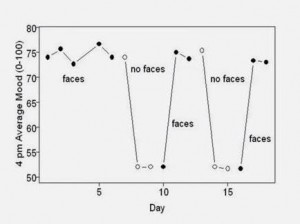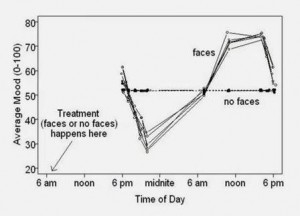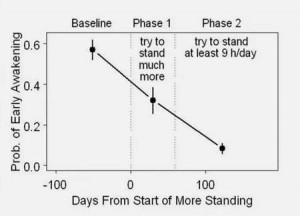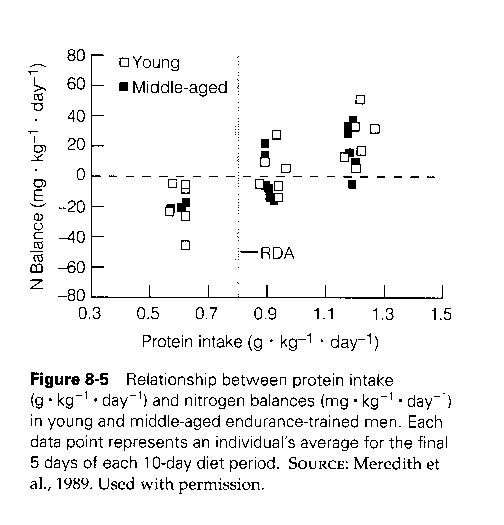I’d like to thank Todd Hargrove for his guest post (How to Do Joint Mobility Drills, July 26, 2011). It was thought-provoking, and I thought I’d share my reflections on it.
What Is the Goal of Exercise?
When it comes to fitness, the blogosphere tends to emphasize strength and athleticism. This is great, but there are other dimensions to health and fitness that are maybe a bit under-discussed.
As a 48-year-old recovering chronic disease patient, I am not looking to become a competitive athlete, enjoyable though that might be. Rather, I want to maximize health and longevity, and be able to freely and pleasurably move through all the challenges and opportunities life may present. I’ll be happy if I can:
- Be strong enough to freely manipulate my body plus a heavy load.
- Be fit enough to run 3-4 miles with pleasure, play an hour of tennis without getting sore, and sprint faster than common criminals.
- Be mobile enough to move freely and gracefully through the full natural range of motion of all joints without crackling, stiffness, or soreness.
- Develop good posture, circulation, and neurological function, so that my body naturally arranges itself in healthy positions.
The first three goals are not too different from Jamie Scott’s prescription for surviving a natural disaster. He asks: Could you lift yourself over a wall or up to a balcony to escape a tsunami? Sprint-jog 3-4 miles over shattered ground and obstacles to escape the liquefaction zone of an earthquake? Walk 3-4 hours over hills daily when roads are impassable? Get into a low squat to fit in a small shelter, or squeeze through a small opening?
But I have a special interest in neurological health. I had chronic ear infections as an infant, culminating in surgery, and ever since have had poor balance. My central nervous system infection made it much worse. Three years ago I had to sit down to put pants on or take them off; walked into doors; and fumbled and dropped things, as the complete loss of our former collection of wine glasses can attest. With diet and antibiotics I’ve recovered; my balance is now similar to what it was in my 20s – which is to say, poor. I can now stand on one foot for about 20 seconds before I have to put down the other foot to balance myself; that would have been 1 or 2 seconds three years ago, but Shou-Ching can do it indefinitely. When we go hiking in the mountains, Shou-Ching clambers up or down steep rocky slopes like a mountain goat; I have to move with care.
Falls are a major cause of health impairment, broken bones, and mortality in the elderly. It would be great if I can improve nervous system function and balance before I get old and falls become dangerous.
I’m very pleased to start this blog’s discussion of fitness with Todd’s post, because mobility and neurological function are critically important to fitness at all ages – and may be crucial to good health as we age.
The Concept of Body Maps
Let me paraphrase one of the key points of Todd’s post this way:
The brain maintains “maps” of the body … These maps may become inaccurate, out of synch with the physical body … As a result the brain may believe a movement is impossible or dangerous and block its performance, even if the body is fully capable of performing the movement … With training the brain can learn the true movement capabilities of the body and revise its maps to more accurately reflect reality, thus increasing the body’s ability to move freely.
The idea that brain “maps” of the physical body, rather than the actual body, are what sets the limits to motion reminded me of a TED video I had seen by Dr. Vilayanur Ramachandran. He is a neuroscientist who investigated the problem of “phantom pain” in the lost limbs of amputation victims, and showed that the pain could be cured by “mirror box” therapies that fooled the brain into manipulating the lost arm and thereby re-drawing the brain’s body maps. Here is his fascinating TED talk:
Todd explains how improper brain maps can lead to chronic pain, and how repairing the brain maps can end the pain. This is an important idea for those suffering from chronic pain.
Use It Or Lose It
Todd observes that
While movement will clarify maps, lack of movement will tend to blur them. In a famous experiment, researchers found that sewing a monkey’s fingers together for a few weeks caused its brain to map the fingers as one unit, not as two separate parts capable of individual movements.
So if I want my brain to remember what my body is capable of, I need to regularly take my body through a diversity of movements.
This is an important reminder for someone who spends 12 hours per day at a desk. Get away from the desk, even if only for a few minutes a day, and move!
The Strategy of Slow, Mindful Movement
When I was young I wanted to do everything fast. (Shou-Ching complains that when I’m behind the wheel of a car, I think I’m still young.) But now I’m starting to appreciate the benefits of slow motion.
Todd’s list of ways to “maximize the benefit of mobility exercise” emphasizes slow, mindful movements. A few thoughts on each:
“Avoid pain and threat.” Since the purpose of the brain’s body maps is to prevent dangerous movements from happening, to re-draw the maps we have to teach the brain that “dangerous” movements are actually safe. For this to be persuasive, they must actually be safe. But this corollary may be less obvious:
Make sure the movement does not … create other signs of threat such as holding the breath, grimacing, collapsing your posture, or using unnecessary tension.
I’m a fan of the mobility videos of Kelly Starrett at mobilitywod.com, and he frequently advises one never to make a “pain face” or grimace, but rather to maintain a cheerful “Zen face.” A grimace during a challenging stretch or movement may be enjoyable, but it might detract from the value of the exercise. Interesting!
“Be mindful and attentive.” This one comes easily to me: I am introspective and enjoy listening to my body and paying attention to muscles, breath, and blood flow during exercise. It’s good to know that’s beneficial.
“Use novel movements.” I like routine, but routine mobility drills are unproductive. Movements need to explore new capabilities.
“Easy does it.” Move slowly and gently. This calls to mind the classic Chinese exercise forms, like Qi Gong and Tai Chi; they are characterized by slow, flowing, graceful movements.
“Be curious, exploratory, and playful.” I like the evolutionary inference Todd makes here:
All animals engage in the most play during the times of their lives when the educational demands are the highest. This means that play is the best solution to difficult education problems that evolution has found.
I think we sometimes fall into the trap of thinking that adulthood implies seriousness and sobriety. No! Rather, good health implies lifelong playfulness.
In Boswell’s Life of Johnson, in the Dedication, Boswell writes:
It is related of the great Dr. Clarke, that when in one of his leisure hours he was unbending himself with a few friends in the most playful and frolicksome manner, he observed Beau Nash approaching; upon which he suddenly stopped. “My boys,” said he, “let us be grave – here comes a fool.”
Let us not be fools, and play!
Can Rhythmic Movement Be an Ultradian Therapy?
I’ve done several posts on the subject of circadian (day-night) rhythms, and how enhancing these rhythms with diet, light, sleep, and exercise may be therapeutic for many diseases. See, for instance, Intermittent Fasting as a Therapy for Hypothyroidism (Dec 1, 2010) and Seth Roberts and Circadian Therapy (Mar 22, 2011).
But humans have other natural biorhythms that cycle more frequently. These “ultradian rhythms” can be quite short. For instance, some hormones are released in pulses – I believe insulin and thyroid hormone may operate this way – and I believe a common interval between pulses is 6 seconds.
Many classic movement forms, like yoga or qi gong, emphasize that movement should be synchronized with breathing, and that breathing should be slow and rhythmic – often with about ten breaths per minute, or six seconds per breath.
The coincidence between these numbers intrigues me. If enhancing circadian rhythms is therapeutic for disease, might enhancing ultradian rhythms by mindful “synching” of the breath to their period be therapeutic for hormonal dysfunction?
It’s just a thought. Many people with glucose regulation issues have disrupted ultradian rhythms for insulin secretion. The ultradian clocks in their pancreatic beta cells aren’t working properly. Wouldn’t it be interesting if mindful breathing, as in yoga, could improve insulin secretion and glucose regulation?
This is not such a far out idea. Consider these quotations from recently published papers:
Mind-body modalities based on Eastern philosophy, such as yoga, tai chi, qigong, and meditation … have many reported benefits for improving symptoms and physiological measures associated with the metabolic syndrome…. Findings from the studies reviewed support the potential clinical effectiveness of mind-body practices in improving indices of the metabolic syndrome. [1]
Participation of subjects with T2DM in yoga practice for 40 days resulted in reduced BMI, improved well-being, and reduced anxiety. [2]
Yoga-nidra practiced for 30 minutes daily up to 90 days, parameters were recorded every. 30th day. Results of this study showed that most of the symptoms were subsided (P < 0.004, significant), and fall of mean blood glucose level was significant after 3-month of Yoga-nidra. This fall was 21.3 mg/dl, P < 0.0007, (from 159 +/- 12.27 to 137.7 +/- 23.15,) in fasting and 17.95 mg/dl, P = 0.02, (from 255.45 +/- 16.85 to 237.5 +/- 30.54) in post prandial glucose level. Results of this study suggest that subjects on Yoga-nidra with drug regimen had better control in their fluctuating blood glucose and symptoms associated with diabetes, compared to those were on oral hypoglycaemics alone. [3]
[F]asting plasma insulin was significantly lower in the yoga group. The yoga group was also more insulin sensitive (yoga 7.82 [2.29] v. control 4.86 [11.97] (mg/[kg.min])/(microU/ml), p < 0.001). [4]
There are fifty-six papers in Pubmed on “yoga diabetes”, and only four of them date before 2002. Most were published after 2008. This is an emerging area of research, but it would be interesting if slow, mindful movement proves to be an effective therapy for metabolic disorders. Maybe exercise doesn’t need to be vigorous to heal disorders like diabetes and obesity!
The Best Exercises for Mobility
I asked Todd what traditional movement forms he would most recommend. He replied:
In my blog I made some lists of exercises styles, traditional and modern, which are in line with what I recommend: the Feldenkrais Method, Z-Health, Alexander Technique, and tai chi are at the top of the list.
My favorite is the Feldenkrais method, but I think for purposes of your blog, some tai chi videos would be perfect, because they really provide a picture of what I’m talking about. You can’t do tai chi without observing all of the guidelines I provide at the end. And it looks cool.
You might include a point that the magic of tai chi is not so much in the specific forms they use, but in the WAY they move – smooth and slow. And the mind state while moving – mindful, relaxed, attention to small details and subtleties. You could apply this tai chi style to anything and get benefit – sitting, standing, walking, lifting weights or doing joint mobility drills.
All of these movement disciplines are extremely interesting, and I hope to get help exploring them in future blog posts. I know that a number of Z-Health Master Trainers have read our book, and hopefully one of them will teach us about Z-Health.
In closing, here are some videos of Qi Gong and Tai Chi movements. With videos available on DVD or on YouTube, there’s no need to join a class to learn mobility drills. You can play a video in your TV and practice slow, mindful, relaxed movements at home.
Perhaps the most valuable movements, in my view, are those used as “warm-up” exercises in Tai Chi or beginning movements in Qi Gong. Here is a well-made introductory video:
Here is a beautiful exhibition of Tai Chi:
Thanks, Todd. I very much appreciate the opportunity to learn about fitness from an expert!
References
[1] Anderson JG, Taylor AG. The metabolic syndrome and mind-body therapies: a systematic review. J Nutr Metab. 2011;2011:276419. http://pmid.us/21773016.
[2] Kosuri M, Sridhar GR. Yoga practice in diabetes improves physical and psychological outcomes. Metab Syndr Relat Disord. 2009 Dec;7(6):515-7. http://pmid.us/19900155.
[3] Amita S et al. Effect of yoga-nidra on blood glucose level in diabetic patients. Indian J Physiol Pharmacol. 2009 Jan-Mar;53(1):97-101. http://pmid.us/19810584.
[4] Chaya MS et al. Insulin sensitivity and cardiac autonomic function in young male practitioners of yoga. Natl Med J India. 2008 Sep-Oct;21(5):217-21. http://pmid.us/19320319.
















Recent Comments